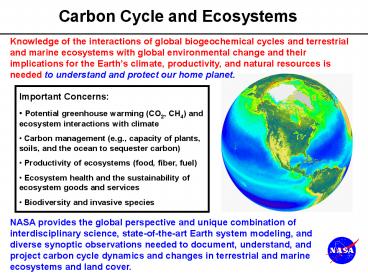Carbon Cycle and Ecosystems - PowerPoint PPT Presentation
Title:
Carbon Cycle and Ecosystems
Description:
Productivity of ecosystems (food, fiber, fuel) Ecosystem health and the sustainability ... science, state-of-the-art Earth system modeling, and diverse synoptic ... – PowerPoint PPT presentation
Number of Views:69
Avg rating:3.0/5.0
Title: Carbon Cycle and Ecosystems
1
Carbon Cycle and Ecosystems
Knowledge of the interactions of global
biogeochemical cycles and terrestrial and marine
ecosystems with global environmental change and
their implications for the Earths climate,
productivity, and natural resources is needed to
understand and protect our home planet.
- Important Concerns
- Potential greenhouse warming (CO2, CH4) and
ecosystem interactions with climate - Carbon management (e.g., capacity of plants,
soils, and the ocean to sequester carbon) - Productivity of ecosystems (food, fiber, fuel)
- Ecosystem health and the sustainability of
ecosystem goods and services - Biodiversity and invasive species
NASA provides the global perspective and unique
combination of interdisciplinary science,
state-of-the-art Earth system modeling, and
diverse synoptic observations needed to document,
understand, and project carbon cycle dynamics and
changes in terrestrial and marine ecosystems and
land cover.
2
Integrated global analyses
Carbon Cycle and Ecosystems Roadmap
Human-Ecosystems-Climate Interactions (Model-Data
Fusion, Assimilation) Global Air-Sea Flux
Sub-regional sources/sinks
T
Funded
High-Resolution Atmospheric CO2
Unfunded
Process controls errors in sink reduced
Southern Ocean Carbon Program, Air-Sea
CO2 Flux
Partnership
Models w/improved ecosystem functions
T Technology development
Physiology Functional Types
T
Reduced flux uncertainties coastal carbon
dynamics
Coastal Carbon
Field Campaign
Reduced flux uncertainties global carbon
dynamics
Global Ocean Carbon / Particle Abundance
Goals Global productivity and land cover change
at fine resolution biomass and carbon fluxes
quantified useful ecological forecasts and
improved climate change projections
Vegetation 3-D Structure, Biomass, Disturbance
T
Terrestrial carbon stocks species habitat
characterized
CH4 sources characterized and quantified
Global CH4 Wetlands, Flooding Permafrost
Knowledge Base
Global Atmospheric CO2 (OCO)
Regional carbon sources/sinks quantified for
planet
N. American Carbon Program
N. Americas carbon budget quantified
Effects of tropical deforestation quantified
uncertainties in tropical carbon source reduced
Land Use Change in Amazonia
2002 Global productivity and land cover
resolution coarse Large uncertainties in
biomass, fluxes, disturbance, and coastal events
Models Computing Capacity
Process Understanding
Case Studies
Improvements
P
Land Cover (Landsat)
LDCM
Land Cover (OLI)
Systematic Observations
Ocean Color (SeaWiFS, MODIS)
Ocean/Land (VIIRS/NPP)
Ocean/Land (VIIRS/NPOESS)
Vegetation (AVHRR, MODIS)
Vegetation, Fire (AVHRR, MODIS)
IPCC
IPCC
2010
2012
2014
2015
2008
2002
2004
2006
Global C Cycle
Global C Cycle
NA Carbon
NA Carbon
3
Forward
Anticipated Progress in Answering the Questions
Where we are now
Where we plan to be
Global primary productivity and land cover time
series available at coarse (8 km resolution)
only short time periods and certain regions at
higher resolutions.
Decadal variability in global productivity
quantified at moderate (1 km) resolution
Periodic global land cover change analyzed at
fine (30 m) resolution.
Available observations (in situ) of global CO2,
biomass, plant community vertical structure, and
species functional groups insufficient to resolve
many issues.
New observations (space-based) enable
quantification of carbon and nutrient storage and
fluxes, disturbance and recovery processes, and
ecosystem health.
Large uncertainties in N. Hemisphere terrestrial
carbon storage, ocean uptake and storage,
permafrost outgassing, and tropical land use
effects. Global carbon budget not balanced.
Carbon sources and sinks identified and
quantified at sub-regional scales (100 km), with
small errors. Global carbon budget balanced on
annual basis.
Earth system models able to correctly portray
most interannual variations and multiple,
interacting controlling processes, with
sub-regional specificity and useful predictive
capability.
Ecosystem and carbon models resolve only large
year-to-year variations multiple controlling
processes not well quantified. 50-year
projections vary widely.
2002 2015
4
Predicting Carbon Cycling
Anticipated Outcomes and Uses of Results
Result / Capability
Products / Uses for Decision Support
Quantitative global monitoring evaluation
tools to assess the efficacy of carbon
management (e.g. sequestration in biomass) to
assess agricultural, forest, and fisheries
productivity for use in verifying emissions
and/or sequestration reporting by nations/sectors.
Global primary productivity and land cover change
time series variability and trends quantified at
moderate to fine spatial resolution. Carbon
sources and sinks identified and quantified.
Quantification of carbon and nutrient storage and
fluxes, disturbance and recovery processes, and
ecosystem health. Quantification of controlling
processes and their interactions.
Maps, data products and information on
relationships among them as input for decision
support systems. Simulation models that enable
If , then scenarios to be explored.
Models that - achieve carbon balance -
reliably characterize interannual variability
and sub-regional processes -
quantitatively portray multiple, interacting
controlling processes - are able to correctly
simulate past land cover, ecosystem
dynamics and biogeochemical cycling
Ecological Forecasts Projections of changes in
carbon sources and sinks, land cover, and
ecosystem dynamics due to combinations of
real-world forcings of global environmental
change with sub-regional specificity and good
reliability for 6 mos. to 2 years into the
future (e.g., harmful algal blooms, invasive
species). ---------------------------------------
----- Inputs for Climate Projections Credible,
useful projections of future climate change
(including improved ecosystem feedbacks and
projections of CO2 and CH4 concentrations) for
50-100 years into the future for a variety of
policy-relevant if , then scenarios.































